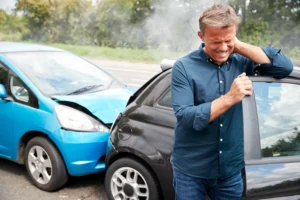Road to Recovery: Navigating Injury After an Auto Accident
 For many, summer is synonymous with road trips—bicycles tied down, coolers stacked between luggage piled high, and the miscellaneous hiking boot or shovel tucked in alongside hopes and dreams for the journey ahead. This summer, despite soaring gas prices, nearly 80% of us will take to the roads, according to a travel forecast survey conducted by The Vacationeri. The survey indicated that of the 206 million Americans embarking on road trips this summer, 47 million will road trip more than 500 miles from home while another 17 million Americans will road trip more than 1,000 miles from home.
For many, summer is synonymous with road trips—bicycles tied down, coolers stacked between luggage piled high, and the miscellaneous hiking boot or shovel tucked in alongside hopes and dreams for the journey ahead. This summer, despite soaring gas prices, nearly 80% of us will take to the roads, according to a travel forecast survey conducted by The Vacationeri. The survey indicated that of the 206 million Americans embarking on road trips this summer, 47 million will road trip more than 500 miles from home while another 17 million Americans will road trip more than 1,000 miles from home.
Our propensity for road travel isn’t limited to the summer months. In fact, U.S. roads are among the busiest in the world. Unfortunately, with increased traffic volume comes increased accident frequency. Between two and three million Americans are injured in motor vehicle crashes on U.S. roads each year—with more than two million Americans injured seriously enough to require medical attention.
Common Accident Injuries
 The significant, and often violent, forces of a car crash can cause tremendous damage to your body as it’s slammed, crushed, bent, and twisted. Among the most common car crash injuries are bruising and contusions; broken bones; whiplash (painful strains in your muscles and ligaments caused by the intense crash forces jolting your body); neck and back trauma; concussion; traumatic brain injury; internal bleeding; and emotional trauma. Even after the most dramatic of car crashes, bodily injuries may not be immediately visible or obvious. That’s why one of the most important steps to take after experiencing a car crash is to seek a medical examination—even if you don’t feel any immediate pain or see any immediate damage. It’s also important to be aware of anything out of the ordinary— headaches that don’t subside, numbness or tingling, nausea or abdominal pain, bruising or discoloration, swelling, unexplained pain. These symptoms can be signs of serious injury only detected in a medical setting. Some injuries like whiplash may not appear until days later. Other common accident injuries—such as spinal trauma, rib fractures, compressed discs, and neck or back damage—may not be readily apparent and, if left untreated, could lead to chronic, debilitating pain.
The significant, and often violent, forces of a car crash can cause tremendous damage to your body as it’s slammed, crushed, bent, and twisted. Among the most common car crash injuries are bruising and contusions; broken bones; whiplash (painful strains in your muscles and ligaments caused by the intense crash forces jolting your body); neck and back trauma; concussion; traumatic brain injury; internal bleeding; and emotional trauma. Even after the most dramatic of car crashes, bodily injuries may not be immediately visible or obvious. That’s why one of the most important steps to take after experiencing a car crash is to seek a medical examination—even if you don’t feel any immediate pain or see any immediate damage. It’s also important to be aware of anything out of the ordinary— headaches that don’t subside, numbness or tingling, nausea or abdominal pain, bruising or discoloration, swelling, unexplained pain. These symptoms can be signs of serious injury only detected in a medical setting. Some injuries like whiplash may not appear until days later. Other common accident injuries—such as spinal trauma, rib fractures, compressed discs, and neck or back damage—may not be readily apparent and, if left untreated, could lead to chronic, debilitating pain.
Roadmap to Recovery
Engaging in the right combination of treatments is key to successfully recovering from an accident. Depending on your injuries, you may need a mix of pain management and physical medicine and rehabilitation treatments such as physical therapy, chiropractic care, and acupuncture.
 At Anodyne Pain & Wellness Solutions, we work with you at every step of your recovery journey. If you’re experiencing pain, our doctors will work with you to identify the root cause of your pain—resolving pain at its source rather than simply suppressing symptoms. Experts in the complexities of pain, our doctors will always treat your pain without surgery or invasive procedures. Instead, our team of pain specialists will partner with you to design a customized pain management plan to identify which of our pain services—which include cutting-edge therapies, injectables, and treatments—best support your near- and long-term healing.
At Anodyne Pain & Wellness Solutions, we work with you at every step of your recovery journey. If you’re experiencing pain, our doctors will work with you to identify the root cause of your pain—resolving pain at its source rather than simply suppressing symptoms. Experts in the complexities of pain, our doctors will always treat your pain without surgery or invasive procedures. Instead, our team of pain specialists will partner with you to design a customized pain management plan to identify which of our pain services—which include cutting-edge therapies, injectables, and treatments—best support your near- and long-term healing.
With our multidisciplinary teams of doctors under one roof, our specialists are able to collaborate and share knowledge about your recovery directly with one another. This unique health care model not only optimizes your care, but also saves you the trouble of running between separate specialists such as physical therapists, chiropractors, acupuncturists, psychologists, among other experts. Together, this dedicated team will relieve, resolve, and rehabilitate to ensure you experience the smoothest of roads to recovery.
To learn more about Anodyne’s personal injury programs, visit https://anodynepain.com/ today.
Related Articles
Whether you’re struggling to diagnose a chronic pain condition or you’re pursuing wellness treatments to stay healthy and feel great, we’re here to support you at every step of your health care journey.
